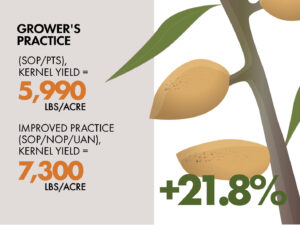HIGHER YIELDS
lncreased kernel weight and size, and improved nutrient density help ensure premium quality nut meat for maximum returns.
STRONGER TREES
Quicker recovery of weakened trees, improved nutrient and water use efficiency, increased ability to withstand stressors (drought, chilling and high light intensity) and reduced fruiting spur dieback.
FASTER UPTAKE
KNO3 is the only K-source that does not cause salt stress. Synergism between K+ and NO3- ensures efficient uptake, improved solubility over competitive sources and better tank mix compatibility.
Almond farmers face many challenges to produce high yielding and high quality crops that bring in premium and steady pricing. One of their major challenges is proper nutrition, especially the critical nutrient of potassium (K). In addition, growers are faced with shortages of water and increasing salinity levels in both water and soil. Choosing the proper K fertilizer source that enhances both yield and quality, improves N recovery and minimizes salinity build-up is vital. This document summarizes UC Davis research findings on the influence of fertigation strategy and nitrogen and potassium sources on the productivity in almond.
Objective:
Contrast tree performance and tree response to various K fertilizer regimes: SOP, PTS, KCI, and Potassium Nitrate (KN). This study took place over a period of 4 years, 2011-2014.
Site:
Commercial Farm- Belridge, CA (Kern county):
- At the start of the trial the orchard was 13 years old and highly productive.
- Average 3-year yields were 3,500 lbs of kernel per acre per year.
- Had received 200 lbs K/acre/year the previous three years.
- Average ammonium acetate extractable K of 107 ppm in top 18 inches and 79 ppm in the 18 to 36 inch depth. July leaf tissue K levels average 1.2%.
Plot details:
- 8 treatments and 5 replicates total.
- 15 trees per replicate.
- Randomized complete block design.
- Results presented relate to Fanjet microsprinkler irrigated applications. Treatments under drip irrigation were non-conclusive.
Treatments and yield results:
-Significant yield gains were had for treatment 5 (combination of SOP and KN) over treatment 2 (combination of SOP and PTS) and treatment 4 (only SOP).
-The increase over treatment 2 (grower standard} was 1,305 lbslac (22%) and over treatment 4 was 1,048 lbslac (17%).
-At an a/mond price of $3.601/b, that's an increase in gross income of $4,698 and $3,773 per acre!!
-Yield increases were statistically significant to the 90% confidence level.
3 year cumulative yield 2012-2014 (lbs kernel/acre)

*AII plots received 300 lb N/acre total (UAN or UAN+KN)
*In year two P was supplied to all plots by using MAP. Total P rate was 103 lbs per acre.
Other reasons to apply KN over PTS and SOP
- Almonds are known to be sensitive to salinity build-up in the root zone, which results in yield reduction when the plant toxic salinity threshold level is exceeded.
- Salinity build-up becomes worse under water scarce conditions (concentration factor: equal amount of salt with less water).
- California lacks water or rainfall to sufficiently flush salts below the rooting zone in order to alleviate salt stress conditions.
- KN (T3,T5) was a better performer than PTS (T2) and 100% SOP (T4), probably because the nutrients in KN (K and NO3) are fully absorbed by the tree and therefore do not contribute to salinity build-up in the soil, as do PTS and SOP, due to the excess of thiosulphate and sulphate (and consequent calcium fixation - gypsum formation).
- Continuous fertigation applied the nutrients to the roots in small but very frequent applications, thus not overloading the soil with an abundance of nutrient salts all at once, as well as increasing nitrogen uptake and nitrogen recovery, which reduces the risk of nitrate leaching.


